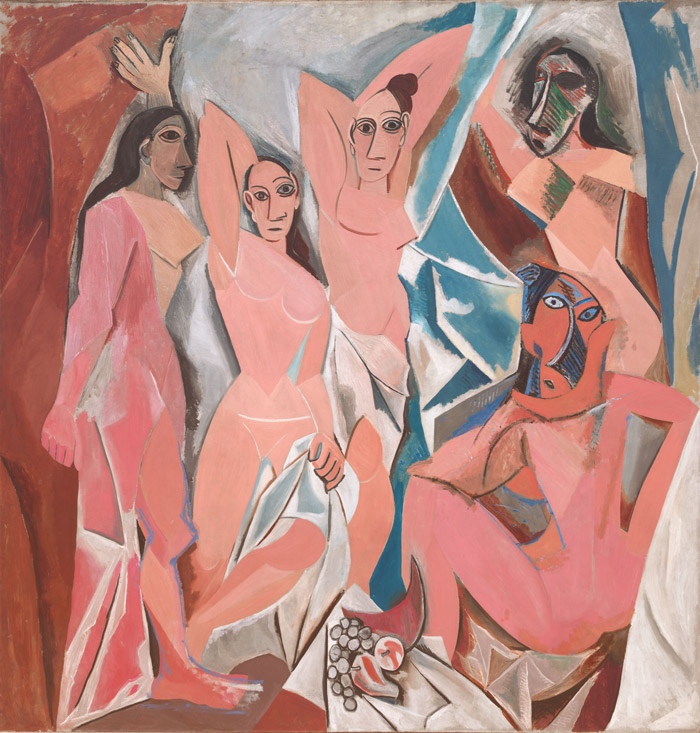3. From Figures to Icons: fifteen stereotypes including the mask
Picasso’s work is obsessively devoted to the human figure. Although this dedication was, in a way, strongly bounded with tradition, it was at the same time the trial ground for one of the biggest pictorial revolutions concerning the arrival of modern art. In Gósol, his work on the human figure turned out to be a safe place to escape from pictorial uneasiness and to exercise the fifteen ways to go into the motif, leading him to an artistic search not for figures but for icons. I use the term icon in a strong sense: Picasso’s icons are images that do not represent anything, but they work as an act of presentation of something in a kind of epiphany of painting, as the ancient images did. Representing the subject is no longer a pictorial goal, but that the goal is to go pictorially into the motif.[1] This meant attaining of a previously unknown degree of autonomy in painting, giving the historical account of the emergence of modern issues via Cézanne and Manet, rather than via Impressionism, Symbolism, or even Matisse’s peculiar aestheticism.
If Picasso’s figures became icons for the first time in Gósol, this was due to the painter finding a new experimental procedure: stereotyping. This meant fixing in a kind of mantric gesture every one of the fifteen ways of going into the motif by trying to provide the simplest solutions to the most complex pictorial problems, as Cézanne used to do, in a kind of “destructive and concluding synthesis” (in Émile Bernard’s words).[2] By means of stereotypes, Picasso succeeded in abandoning narrativity and beauty[3] –yokes that anchored him to tradition– and in liberating the human figure from eloquence, description, anecdote, expression and aestheticism, with a radical new uchronic and utopian aesthetics which, paradoxically, would become of the keys of Picasso’s peculiar modern approach.
The Mediterranean artistic tradition prior to the Renaissance was familiar with presences, stereotypes, icons, and masques. Egyptian bas-reliefs, Greek ceramics, pre-classical kouroi and korai, Doric and Iberian sculpture, Pompeian frescoes, and Romanesque woodcarvings were all part of Picasso’s visual memory. All of these bloomed in Gósol in the fifteen ways Picasso invented to go into the motif, in a return to an origin[4] that liberated painting from its illusionist commitments and took it back to the presentational power of the image. In this blooming, a new universe of forms emerged: forms that were no longer beautiful or agreeable, no longer expressive or eloquent, but rotund, vigorous, and synthetic: three qualities required to erect the autonomous Cézannian motif as Picasso understood it. Actually, the very fact of stereotyping is a plastic option that, by recovering archaic procedures, aims to bring Modernity to the pictorial gesture. This procedure remained encrusted in Picasso’s long-lived creativity, having a powerful hatching in the Portrait of Gertrude Stein and in Les Demoiselles d’Avignon.
[1] I think this is the sense of Jeff Wall’s appreciation about Cezanne’s work: “Cézanne has opened the road to the reduction of the intensity of the subject in painting”. Quoted by Brigitte Léal in Odile Billoret-Bourdy and Michel Guérin (Eds.), Op. Cit.: 15.
[2] Émile Bernard, “Paul Cézanne”, L’Occident, July 1904, in Michel Doran, Conversations avec Cézanne. Paris, Macula, 1978: 46.
[3] See André Malraux, La Tête d’Obsidienne (Paris, Gallimard, 1974), 86.
[4] The originality of the return to the origin, in contrast with the originality of Manet and his mundanity, can be also appreciated in the enthusiasm of Cézanne for prehistorical remains in his settings and for Picasso, in the fossils of Gósol. See Faya Causey’s talk about Cézanne and Antiquity http://www.nga.gov/content/ngaweb/audio-video/audio/cezanne-causey.html





 Summary
Summary